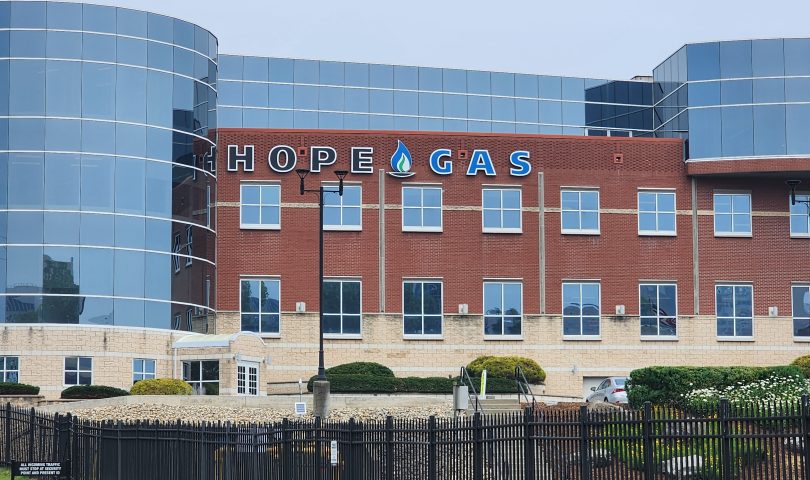MORGANTOWN – Hop Gas has received support for its proposed Morgantown-area pipeline project from state Public Service Commission staff and from another gas provider – Charleston-based Mountaineer Gas Co.
The pipeline is planned to run a total 30 miles from Wadestown in western Monongalia County eastward to the edge of Morgantown and then northwest to site near Osage, at an estimated cost of $177,437,169.
Two members of PSC staff offered testimony of support to the PSC.
Karen Macon, director of the Utilities Division said that PSC staff, and other interested parties have pointed out the need for additional Hope capacity and supply for several years.
She referenced prior testimony by Craig C. Colombo, Hope’s vice president of gas supply, about the need to meet peak day requirements, which is a hypothetical day where extreme weather conditions require Hope to supply its customers without interruption.
Reviewing the numbers and a 2021 case involving Morgantown Energy Associates, she said, “it was abundantly clear that at that time Hope was unable to provide” the supply MEA was asking for, and “there was a lack of additional firm service [a firm quantity commitment] that could be acquired by Hope to serve the existing and growing demand.”
Meanwhile, other Hope customers have requested higher levels of supply, she said, including Mountaineer Gas and Cardinal Gas, which both serve the Morgantown area. “It is clear that the Morgantown area is an absolute growth area in the state of West Virginia.”
She repeated her comments from the 2021 MEA case: “In Staffs opinion, Hope has placed itself in a position where it cannot quickly respond to economic development in certain high growth-restricted capacity areas in the state – hindering both its ability to expand and the ability of the state to grow economically. Hope should consider increasing its focus on securing capacity and corresponding supply to improve the situation.”
She concluded, “I recommend approval of this project.”
PSC engineer Jefferson Brady told the PSC that the project is both necessary and convenient – with convenient meaning it serves the public interest and is an appropriate means of addressing the need.
“Hope’s excess firm capacity [ability to deliver additional supply on demand] is adequate today but has been fluctuating in the recent past in a generally decreasing manner. This means that the company has limited flexibility to accommodate additional requests for service and/or requests for additional Maximum Daily Volume. Hope has documented that existing customers have requested additional MDV as well as their belief that new MDV customers will connect as soon as capacity is made available.”
The project plans are sound from an engineering perspective, he said. “Hope has developed this project over time utilizing tried and true engineering methodology.”
Because it parallels existing pipeline, he said, there will be no planned service outages.
Speaking for Mountaineer Gas, Thomas D. Westfall, vice president for Gas Supply and Technical Services, told the PSC, “Mountaineer Gas Company fully supports Hope’s proposed construction of the Morgantown Connector Project, and commission issuance of a certificate for the project as requested by Hope.”
He also noted that Morgantown is a growth area, and both Mountaineer and Hope have experienced increased demand and constrained supply.
“Hope’s Mountaineer Connector Project will bring additional needed firm gas supply to Morgantown, which will benefit Hope’s and Mountaineer’s customers,” he said.
The new line would begin at Hope’s interconnect with a Columbia Gas line near Wadestown. Using new and existing Hope right of way, it would run 25 miles to the Western edge of Morgantown to connect with other proposed Hope facilities (called Black Night) west of I-79 and Harmony Grove. Hope says about 5.5 miles of that right of way is in northern Marion County.
From Black Night, the line would use existing and new third-party rights of way to go five miles northwest of Granville to a measurement & regulations station called Mineral northwest of Osage.
Hope notes that about 14.5 miles of the project is parallel to existing Hope right of way or to other lines, to allow for grouped utilities and making the most of an existing corridor.
The project would include 30 miles of 16-inch diameter steel gas line and “uprating” of 5.6 miles of existing 12-inch line to accommodate the increased pressure and new gas supply.
Hope estimates that the project will generate about 600 jobs, which will make up about half the project cost. Other major costs are the 30 miles of pipeline and five new measurement and regulation stations.
The project is expected to affect 170 landowners and 233 land parcels.
Rebuttal testimony in the case is due Dec. 13. A public comment hearing is set for Dec. 13 and an evidentiary hearing on Dec. 14. Initial briefs are due Jan. 10 and reply briefs on Jan. 24.
Email: dbeard@dominionpost.com




